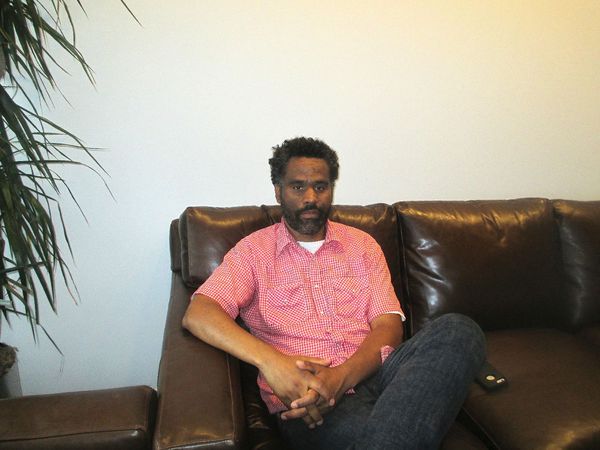 |
| Fresh Dressed Sacha Jenkins on Givenchy's Riccardo Tisci: "And he is someone who has been a big supporter and fan of Hip-Hop." Photo: Anne-Katrin Titze |
Crisply edited by Andrea B. Scott, shot by David Vollrath, who worked with Morgan Neville on the Oscar-winning 20 Feet From Stardom, out-of-the-box Fresh Dressed delivers the goods. Mixed with clips of Will Smith in The Fresh Prince Of Bel-Air and In Living Color's Fly Girls, where Jennifer Lopez got her fresh start, we learn the history of Carl Jones' Cross Colours label. Through interviews with Pharrell Williams, Damon Dash, Kanye West, Nas (Nasir Jones), André Leon Talley, Sean Combs, Ralph McDaniels, Marc Ecko, Karl Kani, Daymond John and others, discussing their fascinations that include Little Richard, Dennis Hopper's Easy Rider with Peter Fonda and Jack Nicholson, Louis Vuitton, an obsession with Polo by Ralph Lauren in the early Nineties, Gucci logos, Tommy Hilfiger give-aways, Sacha Jenkins takes a discerning look at the implications that come with being or not being fresh dressed.
 |
| Pharrell Williams with Tommy Hilfiger |
Givenchy creative director, Riccardo Tisci, and Public School's Dao-Yi Chow and Maxwell Osborne, who joined Donna Karan's DKNY this April as creative directors, are among the industry greats speaking about their urban fashion influences. April Walker and Fashion Institute of Technology's Elena Romero address the gender gap in the mostly male phenomenon of Hip-Hop, while Nas calls Dapper Dan “Tom Ford before Tom Ford.”
Jazz, church, African chiefs, customised denim jackets, the ritual it takes to achieve "fat laces", Kangol hats and Cazal glasses, Jenkins persuasively casts a wide net in pursuit of an understanding on inner city culture, exploring much more than the relationship between music and fashion. Going back to the times of slavery, when the expression "Sunday best" was invented, Fresh Dressed, through clothes, links the past to a present where the future remains unresolved.
On the morning of the New York premiere of his documentary, Sacha Jenkins gave me an in-depth look at his motivations for taking on the challenge of making Fresh Dressed.
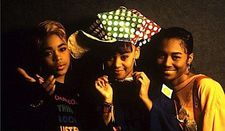 |
| TLC in Carl Jones’ Cross Colours |
Anne-Katrin Titze: The definition of "fresh" is what you begin with. Then the film loses it for a while and comes back to it in the end. Did you know that you wanted "fresh" in the title?
Sacha Jenkins: Yeah, I mean, growing up in the Eighties, "fresh" was a term that we used pretty often to describe things in general that were superior, that were excellent or exciting. In the fashion context it comes to mean something that's brand new, out-of-the-box. And in the inner city where people don't have much, the idea of showing people that you're wearing something that's brand new goes beyond the idea of function. What you wear is a whole other language, it's a whole other level of communication. It's saying to people, "hey, I know we're all poor, but I can afford this. And that separates me from everyone else."
AKT: Well, it separates me from everyone else but at the same time it's a trend that is wide. You always imply that question of individuality and of uniform.
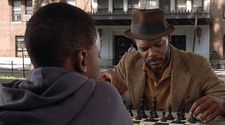 |
| Definition of fresh: "In the fashion context it comes to mean something that's brand new, out-of-the-box." |
SJ: It's about language. Growing up in New York back then, based on how someone was dressed, you could tell without speaking to them, where they were from. Whether they were from Brooklyn or Queens or Manhattan, simply based on how they looked. Of course, you're dealing with young people and trends and wanting to be cool. You're dealing with individuality, you're dealing with competition, because along with it being a language, it was a competitive language. Saying, "I have those sneakers that you don't have. What do you have? That makes me cooler."
I don't know enough about the high fashion world, to where if it's on that same level. Are people competitive to the extent where it's like "I have this dress that no one else has?" I think, doing a film about fashion and using fashion as a platform to address a bigger picture conversation is a good way in, because fashion is universal. I think everyone, no matter where you are or how much money you have, everyone wants to look good and feel good.
AKT: Todd Boyd [Professor at the University of Southern California] talks early on in your film about the history of African American culture expressed through fashion in the 20th century. Did you want to address a bracket of that culture with Fresh Dressed, starting in the Eighties through the early 2000s?
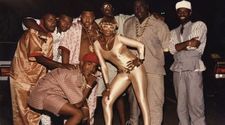 |
| Dapper Dan creations |
SJ: Well, we started it with slavery. I thought it was important for people to understand the notion, the idea of "Sunday Best". You ask anyone in America, what does Sunday Best mean, and they tell you it means to look good on Sunday in church - which is halfway true. Most people don't know that it came from a time when slave owners were mandated by their states to buy their slaves one nice church outfit to worship a God that is completely foreign to them. To dress in a European manner. So I wanted to start as far back as slavery to set the stage. You go from slavery to the South Bronx, which, you know, it looks like World War II Poland. The crime in it, the education or lack thereof, the situation with the police. Flash forward to now. Not much has changed.
You see all this police brutality and those gang members on a local television show back then. And the commentator says: "You guys are all dressed like warriors. Why are you dressed like warriors? Who is your enemy?" The enemy is the police and they are very racist. So you are looking at 1971 Bronx, New York and look at where we are now! And how things have not changed. That's why I was excited as someone who grew up in the culture, that fashion could be a way to address all of these things.
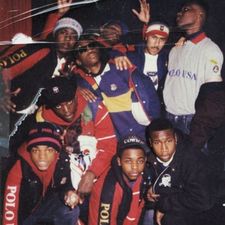 |
| Polo Ralph Lauren |
I remember growing up and there were times of the year when we had breaks for school. When you came back after Christmas break or Easter break, you had to have new clothes. And if you didn't, you'd be ridiculed. And so many kids I knew who couldn't afford the clothes would sell crack. Some of the kids in 1986 were making a thousand dollars a day. In 1986! They could buy all the clothes they wanted. There was a sense you'd be ridiculed by your own peers if you didn't have these things. If you think - lack of education, lack of opportunity, it all boils down to: but you have to have clothes. Like Kanye says in the film, "I just wanted money to be fresh." Where does that come from?
AKT: You have a wide range of interviews. André Leon Talley had a cold?
SJ: Ah, you picked up on that?
AKT: I have spoken to him a few times, so I noticed. He brings up Little Richard as groundbreaking for him. I liked how he dressed for the interview with you. But tell me a bit more about Dapper Dan and the pivotal role he and his shop played.
SJ: Well, Dapper Dan was a boutique owner in Harlem. He was a fan of Gucci and Louis Vuitton and all these brands and he wanted to sell them in his shop in Harlem. But they refused to sell to him. He wasn't able to get an account. So he said, hey, you know what? I really like this stuff and I know people around here would really like it. I'm going to take what they do and put me in it. And that for me is a metaphor for what Hip-Hop is, a metaphor for what the black experience has been in America.
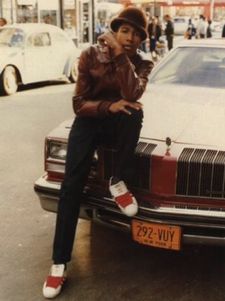 |
| Kangol hat and Fat laces |
Hip-Hop music samples classical and jazz, makes something original and then puts an attitude on top of it. The attitude is the rapping, it's the words. So Dan said, if I'm going to use what they do and put what I do on top of it, then I know that we are going to love it. It's going to speak to who we are. It's going to speak to what we think is cool. Like the music, he re-mixed something that was pre-existing. Soon all the celebrities, the drug dealers, people with money were spending a premium to go to Dapper Dan and get stuff that you couldn't get anywhere else.
AKT: You interviewed Riccardo Tisci. Why did you choose him?
SJ: Well, because he is referenced in so many rap songs. These designers today, you know, the rappers revere them so much. And he is someone who has been a big supporter and fan of Hip-Hop. A lot of folks in the mainstream fashion establishment initially didn't want to have a direct association with a lot of people in Hip-Hop. Riccardo was someone who grew up with the culture and the music.
AKT: He talks about how excited he was when friends brought him things back to Italy from New York.
SJ: Yeah, Hip-Hop was his music. Now you have generations of kids who are not from the inner city, Hip-Hop was their music, their muse and their inspiration. And Riccardo was just a reflection of that.
AKT: April Walker is the only woman designer in the film. Were there others you interviewed?
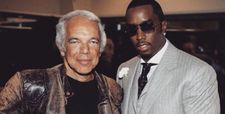 |
| Ralph Lauren with Sean "Puffy" Combs |
SJ: There were others. I interviewed 80 people. I interviewed way too many people. The truth of the matter is, Hip-Hop, overall, is a boy's club. The fashion, especially early on, if you look at it, women were wearing men's clothes.
AKT: You bring it up for a time in the Nineties when women were wearing the same baggy clothes. At other times, you have clips of that from music videos, with fully dressed men in the foreground with scantily clad women as backdrop.
SJ: In the music videos the women are just objects. Hip-Hop is extremely male centric and I think the clothing again is a reflection of that. That's why clothing is such a powerful tool to take you through the expanse of what Hip-Hop is and also for Hip-Hop to examine itself. There were always women involved with Hip-Hop, but if they weren't dressed like Hip-Hop, then they weren't cool. And what was cool at that time was basically dressing like a boy, like a tomboy. There haven't been also many successful female rappers.
AKT: That would make for an interesting subject of a film, too.
 |
| Cazal glasses |
SJ: 100%. We had Elena Romero talk, who is sort of an expert and also teaches fashion and design [at FIT in New York]. So I got some women in there. There could have been more, for sure.
AKT: Public School are great. You caught an interesting moment on camera when Dao-Yi Chow and Maxwell Osborne talk about their background, working for Sean John. Did you know it when you had it?
SJ: Yeah, I think it's twofold. I think that they are deep down very proud. At the same time, it didn't necessarily help them in the fashion world because Sean John and Sean Combs did all this amazing work and won all these awards and changed the game, there was still a stigma.
AKT: Sean John was the first time an African American won a CFDA award.
SJ: Yes. There was still a stigma because they did not come from the traditional fashion houses. He said, "A while ago, I wouldn't have been comfortable saying this but now it's okay." That speaks again to the bigger conversation about race and Hip-Hop and people being afraid of it. And now these guys are at Donna Karan [they were named creative directors at DKNY this April] on top of doing Public School.
 |
| André Leon Talley: “Little Richard was an extravagant, outlandish version of Liberace without the sequins." |
AKT: Public School also won CFDA awards.
SJ: There is a photo of them winning that award in the film.
AKT: I found interesting how much you tell us through the background - where the interviews were taking place. Tisci, in his studio, I suppose, a big space with benches. Kanye West has the ocean behind him. Tell me a bit about your decisions of where you placed them.
SJ: I mean, with Kanye, it's not much of a decision. He was somewhere in remote Mexico and we had two days to get there. We lucked out. I'd love to say that I'm some cinematic genius but we lucked out. That's when he was available and that's where we could get him. It's a real reflection, you know, he's in Mexico by the beach making music with his friends and his family. With Kanye you never know what you're going to get.
I've never interviewed him before. He's been in the media, you know, he's Kanye. When I was talking with him, we were talking about fashion, which is something he is very serious about. Very passionate about. I think I got an interview that really captures who he is and where he wants to go and where he came from and where he is - which is on a fabulous beach in Mexico.
AKT: And the other people? Did you film them in their studios or their homes mostly?
SJ: Yeah, I wanted to get people in their environment. Cross Colours, for instance, that was their studio, you know, Karl Kani, it's where people felt most comfortable. These people in fashion are very passionate and connected to their work spaces. It's a big part of what they make, it's almost an extension of who they are.
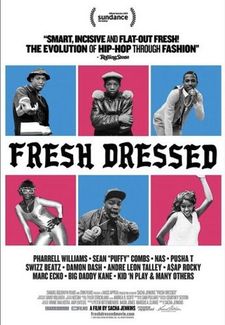 |
| Fresh Dressed US poster |
AKT: I spoke with Livia Firth two days ago about all the terrible consequences of our world of fast fashion. From pollution to human rights violations, and the working conditions of the poorest of the poor who make a large percentage of the clothes consumed today. Is there any connection you were able to make between Hip-Hop fashion and an awareness of possibly going green?
SJ: I mean, when you talk inner city, green is the furthest thing. Because you are dealing with people who live in food deserts. In other words, the supermarkets are ill-equipped, they don't have fresh food or vegetables, they're surrounded by McDonalds and fried chicken places. And because America is about hyper-capitalism, people in the inner city, and all of America, are led to believe that the more you have, the better you are. The better you can feel about yourself. Hence, there's a guy in the film named Mayor who talked about his mother buying him a pair of sneakers when he was a kid and he thought he was cool, because it said "Mark" [his name on the Mark 5 sneaker].
So he goes back to his neighborhood and everyone laughs at him. And he vows never to have that happen again. So he had a love affair with sneakers and now he says in the film "I can wear a brand new pair of sneakers every day for seven [and a half] years." That can't be good for the environment. How many shoes do you need? Why do you have so many shoes? I think, again this notion of self-esteem or lack thereof. The more you have, the better you are.
AKT: This is where it links with the fast fashion consumption. People who cannot afford the rent can go to H&M or other places and buy a new T-shirt for five dollars in the hope to quickly re-invent themselves and fix the self-esteem. But then what? It spirals out of control. Are you planing to make another film?
SJ: You know, working on some things. This film will hopefully get people talking and maybe create some more opportunities for me. For me it's a great privilege, to be who I am and coming from where I am, and to tell this kind of story from the perspective of an insider. I think we need more of that. We need more people who look like me who can articulate these experiences of these worlds. I'm not saying you have to be from where I'm from to tell these stories but I'm saying the stories are going to be better, richer if people like me have the opportunity to tell those stories. I'm excited about telling more stories, for sure.
Fresh Dressed opens in the US on June 26 and had its world premiere at the Sundance Film Festival.





















